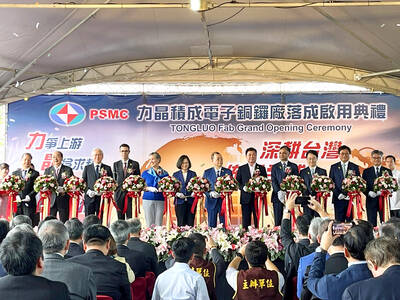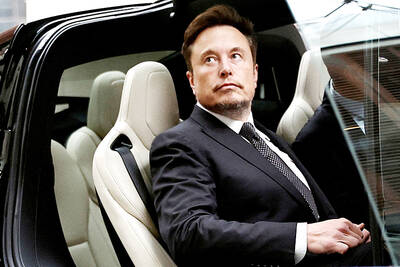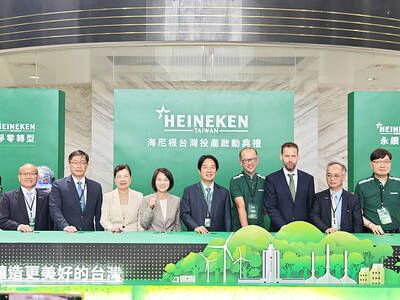Samsung Electronics Co posted a record US$3.4 billion loss at its pivotal memorychip division, but said it expects the global tech industry to begin emerging from its downturn later this year.
It joined SK Hynix Inc in predicting some relief from a broad tech recession that has hit the world’s biggest names from Apple Inc to Intel Corp.
Asia’s largest electronics company yesterday said it expects demand to gradually improve in a range of markets from smartphones to PCs and storage, driven by a Chinese economic recovery and accelerating artificial intelligence (AI) development.

Photo: REUTERS
Samsung, which supplies chips to Apple while making the iPhone’s closest competitor, reported net income of 1.4 trillion won (US$1.04 billion), lagging the 1.45 trillion won average analyst estimate.
Its semiconductor division, typically its largest, posted an unprecedented loss of 4.58 trillion won. Its shares were largely unchanged in Seoul trading.
“The memorychip industry has likely passed the worst of weak demand” in the first quarter, Bank of Singapore investment strategy head Eli Lee said. “Higher-end memory sales will continue to support pockets of demand, especially in 2H23 due to new smartphone launches and AI demand expansion.”
Samsung plans to maintain investment in memory chips at about last year’s level, because it is seeking to safeguard its longer-term competitiveness.
That is despite promising a “meaningful” cut in semiconductor production, a reduction aimed at stabilizing collapsing chip prices.
The South Korean company has historically aimed to spend throughout recessions to protect its lead.
The unusual move, twinned with more upbeat predictions about PC and phone demand, had spurred hopes that the industry would climb out of its trough this year.
Spot memory prices rebounded for the first time in 13 months, shortly after Samsung’s announcement.
On Wednesday, Hynix added to that sentiment after reporting a drop in revenue that was not as bad as feared, and saying it sees memory prices bottoming out in the current quarter.
Micron Technology Inc, the largest US maker of memory chips, said client inventories were declining.
Samsung posted its slimmest operating profit since 2009 just a few weeks ago. Any sustained recovery might hinge on an economic rebound in China, the world’s largest market for PCs and smartphones. That recovery has been uneven, but is gaining steam.
“In the second half, the smartphone market is expected to increase both in volume and value amid signs of a global economic recovery,” it said in a statement.
Samsung stayed in the black during last month’s quarter, in part because its new Galaxy S23 phone series bucked the overall smartphone slump. The mobile division posted a 3.9 trillion won operating profit in the quarter.
Longer term, investors remain transfixed on how a US-China conflict might affect the industry. Beijing launched a review of chips from Micron in March, inciting concerns about a backlash toward US companies and possibly US allies.
China is among South Korea’s largest export destinations, and a key market as well as a production base for Samsung and Hynix.
South Korean President Yoon Suk-yeol is touring the US capital this week, and discussions are likely to center on South Korea’s role in US curbs on exports to China, part of Washington’s effort to contain its political rival.
A blockade on shipments of chipmaking equipment threatens to curtail Samsung’s memory operations in China.

ARTIFICIAL INTELLIGENCE: The chipmaker last month raised its capital spending by 28 percent for this year to NT$32 billion from a previous estimate of NT$25 billion Contract chipmaker Powerchip Semiconductor Manufacturing Corp (力積電子) yesterday launched a new 12-inch fab, tapping into advanced chip-on-wafer-on-substrate (CoWoS) packaging technology to support rising demand for artificial intelligence (AI) devices. Powerchip is to offer interposers, one of three parts in CoWoS packaging technology, with shipments scheduled for the second half of this year, Powerchip chairman Frank Huang (黃崇仁) told reporters on the sidelines of a fab inauguration ceremony in the Tongluo Science Park (銅鑼科學園區) in Miaoli County yesterday. “We are working with customers to supply CoWoS-related business, utilizing part of this new fab’s capacity,” Huang said, adding that Powerchip intended to bridge

purpose: Tesla’s CEO sought to meet senior Chinese officials to discuss the rollout of its ‘full self-driving’ software in China and approval to transfer data they had collected Tesla Inc CEO Elon Musk arrived in Beijing yesterday on an unannounced visit, where he is expected to meet senior officials to discuss the rollout of "full self-driving" (FSD) software and permission to transfer data overseas, according to a person with knowledge of the matter. Chinese state media reported that he met Premier Li Qiang (李強) in Beijing, during which Li told Musk that Tesla's development in China could be regarded as a successful example of US-China economic and trade cooperation. Musk confirmed his meeting with the premier yesterday with a post on social media platform X. "Honored to meet with Premier Li

Dutch brewing company Heineken NV on Friday announced an investment of NT$13.5 billion (US$414.62 million) over the next five years in Taiwan. The first multinational brewing company to operate in Taiwan, Heineken made the statement at a ceremony held at its brewery in Pingtung County. It also outlined its efforts to make the brewery “net zero” by 2030. Heineken has been in the Taiwanese market for 20 years, Heineken Taiwan managing director Jeff Wu (吳建甫) said. With strong support from local consumers, the Dutch brewery decided to transition from sales to manufacturing in the country, Wu said. Heineken assumed majority ownership and management rights

Microsoft Corp yesterday said that it would create Thailand’s first data center region to boost cloud and artificial intelligence (AI) infrastructure, promising AI training to more than 100,000 people to develop tech. Bangkok is a key economic player in Southeast Asia, but it has lagged behind Indonesia and Singapore when it comes to the tech industry. Thailand has an “incredible opportunity to build a digital-first, AI-powered future,” Microsoft chairman and chief executive officer Satya Nadella said at an event in Bangkok. Data center regions are physical locations that store computing infrastructure, allowing secure and reliable access to cloud platforms. The global embrace of AI